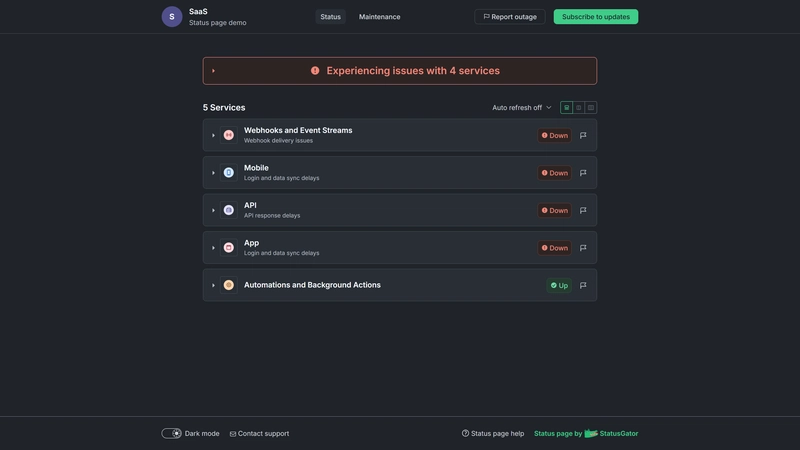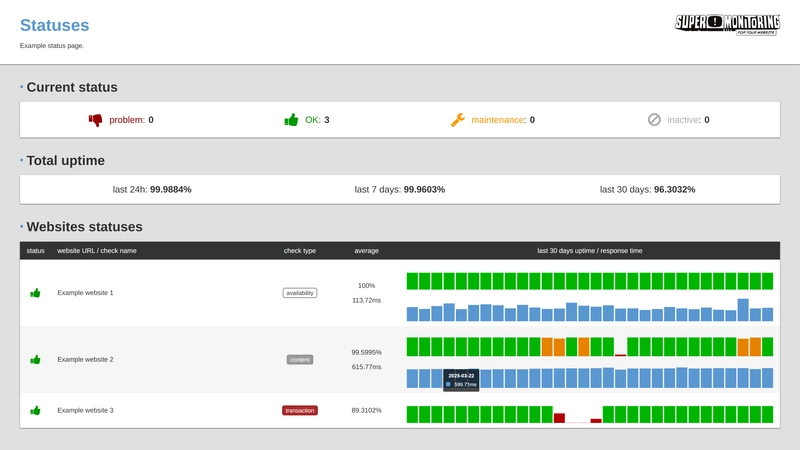When running a SaaS business, transparency is everything, especially when things go wrong. A SaaS status page provides real-time updates to customers during outages, incidents, or scheduled maintenance, reducing support tickets and boosting trust. Instead of leaving users in the dark, it keeps them informed with clear, timely communication.
Beyond incident communication, a good status page offers system health monitoring, incident history, and automated notifications via email, SMS, or other channels.
It’s an essential tool for customer experience and internal operations, especially for SaaS providers with complex infrastructure and third-party dependencies.
In this post, we’ll explore some of the best SaaS status page providers available today, including tools that support public and private pages, incident workflows, and integrations with your existing stack.
We won't be looking at some popular tools like Statuspage.io, UptimeRobot, and Uptime Kuma since these have been covered quite extensively already.
1. StatusGator

StatusGator helps SaaS companies stay ahead of outages, not just on their own platform but also across third-party services. It aggregates the status of over 5,000 cloud services, providing a centralized view of your entire infrastructure stack on a single SaaS status page.
StatusGator helps deliver both transparency and uptime via customizable public and private status pages that track hosting providers, APIs, payment gateways, and more. Whether you rely on services like AWS, Stripe, or Square, StatusGator helps your team stay informed and respond to disruptions before they affect your users.
What makes StatusGator stand out?
One of StatusGator’s standout features is Early Warning Signals,is Early Warning Signals, which detects service anomalies before they're officially acknowledged. During major outages, like the Square downtime in February 2025, StatusGator alerted users several minutes ahead of the provider’s own announcement, giving IT teams a critical head start.
In addition to early detection, StatusGator offers:
- Real-time alerts via email, Slack, Microsoft Teams, and webhooks.
- Branded public SaaS status pages to communicate incidents with users.
- Internal status pages for IT and engineering teams.
- Private API monitoring for enterprise-level transparency.
- Reduced support burden by addressing user concerns before they reach your help desk.
StatusGator is especially valuable for SaaS platforms with complex tech stacks and multiple integrations. Consolidating third-party monitoring into a single status page, it fills a gap that traditional monitoring tools don’t cover.
Whether you’re building trust with users through a public-facing status page or equipping your team with an internal dashboard to track critical vendors, StatusGator is a must-have for modern SaaS operations.
👉 Explore StatusGator and try it for free.
2. Pulsetic

Pulsetic allows SaaS companies to create customizable, real-time status pages that enhance transparency and build customer trust. This status page provider enables businesses to communicate service statuses effectively without requiring technical expertise.
What makes Pulsetic stand out?
No-code customization: Easily tailor your status page to reflect your brand by adding logos, banner images, custom fonts, and brand colors.
Multilingual support: Communicate with a global audience by providing updates in multiple languages, ensuring all users stay informed.
Quick setup: Launch your status page swiftly by configuring a CNAME record and customizing your page, making it accessible on your subdomain.
Subscriber notifications: Keep your users updated by sending notifications about incidents or maintenance directly to their inboxes.
Private status pages: Restrict access to your status page, making it visible only to internal teams or specific stakeholders as needed.
Uptime showcase: Display your service's reliability with an uptime status bar, highlighting performance over selected periods.
For SaaS providers aiming to maintain high levels of customer trust and reduce support inquiries during service disruptions, Pulsetic offers a streamlined and efficient solution.
Pulsetic’s free plan includes customizable uptime badges and monitoring essentials. However, integrations like Slack or SMS alerts are only available in paid plans, making it better suited for smaller teams with minimal requirements.
Paid plans start at $9 per month, and there's a free version too.
3. ODown

ODown offers a public status page solution designed to help SaaS providers communicate outages, maintenance, and real-time uptime data with clarity and ease. Fully customizable and easy to set up, ODown’s status pages help businesses maintain trust by keeping users informed every step of the way.
What makes ODown stand out?
Real-time uptime monitoring: Automatically displays the live status of your website and APIs.
Custom domains: Host your status page at your own URL, like
status.yourcompany.com, for consistent branding.Multi-channel notifications: Let users subscribe to updates via email, Slack, Discord, SMS, or RSS feeds.
Incident transparency: Share historical incidents and average response times to show reliability over time.
Whether you want to reduce support load, boost transparency, or simply keep users in the loop, Odown’s status page platform is a smart choice for SaaS teams serious about reliability and communication.
Prices start at $12 per month.
4. Sorry App

SorryApp offers a focused solution for SaaS companies seeking efficient incident communication without unnecessary complexity. Designed to be quick to deploy and easy to manage, SorryApp enables businesses to keep their users informed during service disruptions.
What makes SorryApp stand out?
Real-time updates: Communicate system status, maintenance schedules, and incident reports promptly.
Customizable status pages: Tailor your status page to align with your brand, including custom domains and themes.
Subscriber notifications: Keep users informed through email, Slack, Microsoft Teams, and Google Chat integrations.
Team collaboration: Support for up to 5 team members with role-based access control and SSO integration via any SAML provider.
API access: Utilize REST and Status APIs to integrate with your existing workflows and systems.
Incident metrics: Track and display incident metrics to provide transparency and build trust with your users.
With a straightforward pricing model of $99 per month, SorryApp includes support for up to 1,000 subscribers, making it a practical choice for SaaS businesses aiming to enhance their incident communication and maintain customer trust.
5. Super Monitoring

Super Monitoring offers a solution for SaaS companies seeking to maintain transparency and trust with their users through customizable public status pages.
These pages provide real-time insights into the operational status of your services, ensuring that your customers are always informed
What makes Super Monitoring stand out?
Unlimited status pages: Create as many status pages as needed, each tailored to different services or audiences.
Custom branding: Personalize each page with your company's name, logo, color scheme, and even custom CSS to align with your brand identity.
Real-time monitoring: Display current status updates alongside historical data, including uptime and average response times over various periods (week, month, quarter, year).
Incident communication: Publish messages regarding ongoing incidents or maintenance directly on the status pages, keeping users informed about the actions being taken and expected resolution times.
Multilingual support: Cater to a global audience with status pages available in English, Spanish, German, and Polish.
Responsive design: Ensure optimal viewing experiences across all devices, from desktops to smartphones.
By integrating these features, Super Monitoring's public status pages serve as a tool for incident communication, helping SaaS providers enhance user trust and reduce support inquiries during service disruptions.
Public status pages are available on plans that cost $14.99+ per month.
6. StatusCast

By consolidating status updates, automating incident responses, and providing detailed analytics, StatusCast empowers organizations to proactively manage service disruptions, thereby enhancing user satisfaction and reducing the burden on support teams.
What makes StatusCast stand out?
Public and private status pages: StatusCast enables the creation of both public-facing and internal status pages, allowing organizations to communicate effectively with external users and internal stakeholders.
Audience-specific pages: Deliver personalized status updates to different user groups, ensuring relevant information reaches the appropriate audience without causing alert fatigue.
Incident management: The platform offers an incident management suite, facilitating efficient handling of outages with on-call management, workflow automation, and root cause analysis tools.
Integrations: StatusCast supports codeless integrations with third-party applications, including monitoring tools, collaboration platforms like Slack and Microsoft Teams, and IT service management systems.
Customization: Fully customize your status pages to align with brand identity using custom CSS, multilingual support, and embeddable widgets.
Subscriber management: The platform provides scalable subscriber management, allowing end-users to manage their own subscriptions and notification preferences directly from the status page.
StatusCast offers a comprehensive solution that not only communicates system statuses but also integrates with existing workflows and tools. Its focus on customization, audience-specific communication, and robust incident management makes it an ideal choice for SaaS providers aiming to maintain transparency and trust with their users.
According to G2.com, StatusCast prices start at $99 per month.
7. Uptime.com

For SaaS businesses, maintaining service reliability and clear communication is paramount. Uptime.com's status page solution not only monitors your services but also ensures that users are promptly informed about any issues.
What makes Uptime stand out?
Customizable public and private status pages: Secured with Single Sign-On (SSO) and local authentication.
Real-time monitoring and alerts: Continuously monitor system health and display real-time statuses. Users can subscribe to receive notifications via email, Slack, or other channels.
Incident management: Get efficient incident reporting and management, schedule maintenance events, and share post-incident analyses.
Historical data: The platform maintains a detailed history of incidents and maintenance events, allowing users to review past issues, understand patterns, and improve future responses.
Its blend of real-time monitoring, customizable communication tools, and brand alignment features makes it a valuable asset for any SaaS provider aiming to uphold transparency and trust.
Prices start at $20 per month.
Summary
Whether you're a growing startup or an established SaaS platform, having a reliable status page is no longer optional — it's essential. The right SaaS status page provider can significantly reduce support volume, build trust with your users, and help your team stay ahead of incidents.
From tools like StatusGator that monitor third-party services, to Pulsetic and Odown with their user-friendly customization, and enterprise-ready platforms like StatusCast and Uptime.com, there’s a solution for every type of SaaS business.
When evaluating your options, consider what matters most for your team and customers: real-time alerts, brand alignment, incident workflows, or private internal dashboards. The good news? Many offer free plans or trials to get started.
Invest in transparency now, and your users will thank you the next time something goes wrong.



Pulsetic is a very good solution.